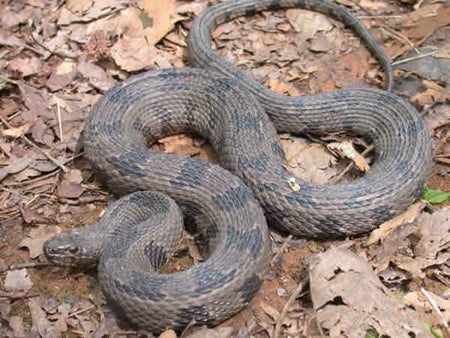SCIENTIFIC NAME:
Nerodia taxispilota
STATUS:
Fairly common in southeastern portion of Coastal Plain. Low Conservation Concern.
DESCRIPTION:
Brown water snakes, Nerodia taxispilota, are large snakes that can reach a total length of 30-55 inches. The longest one on record was almost 70 inches long. Adults are light tan with darker squarish brown blotches down their back. Additional dark squarish markings extend upwards from their belly onto the sides of their body between the dorsal blotches. Their belly is light-colored with darker blotches some of which are shaped like a half moon. Their scales are keeled and there are 25-33 dorsal scale rows at midbody. Their pupils are round. The coloration of juveniles is similar to that of adults. They are nonvenomous snakes though they have stout bodies. Many people mistakenly identify this snake as a cottonmouth (a venomous snake also known as the water moccasin).
DISTRIBUTION:
The brown water snake is native to the Coastal Plain and some of the Piedmont of the southeastern United States. It can be found as far north as Virginia, south through all of Florida, and west to extreme southeastern Alabama. In Georgia, it can be found throughout the Coastal Plain and most of the central Piedmont except for a small section of northeastern Georgia on the border with South Carolina.
HABITAT:
Brown water snakes usually are found in the slow moving waters of canals and rivers, and sometimes in lakes. The species is found in cypress swamps and even occasionally in brackish waters, particularly where there is a lot of overhanging vegetation. They often bask on logs, branches, or bushes above the water, and gently retreat into the water if they are threatened.
FEEDING HABITS:
Brown water snakes primarily feed on fish, but will eat other snakes and have actually been seen with catfish spines protruding from their bodies. The spines eventually break and the snake heals. Brown water snakes have a unique method of capturing their prey. They will hang down from branches over aquatic prey such as frogs capturing them from above. Catfish are a favorite prey item. Some lie on the surface of the water and wait for a fish to swim beneath them. When a fish is within striking range the snake is able to catch it and swallow it alive. They also forage among underwater rocks and debris for prey.
LIFE HISTORY AND ECOLOGY:
Brown water snakes are predaceous carnivores. They play an important role in regulating populations of their prey and help to maintain a balance in their environment. They are excellent climbers and can be found 20 feet or more above the ground in trees. Often, they will lie or bask, on rocks. This warms their bodies in the sunlight and increases their metabolic activity. If startled, they will leap into the water or occasionally (and accidentally) into a boat. They are excellent swimmers, and may stay submerged for long periods of time. If cornered they sometimes flatten their necks and strike viciously. They often release a foul-smelling musk when threatened or handled. They are active both during the day and during the night. During the hottest portion of the year they tend to become more nocturnal (active a night).
Mating takes place during the spring, often in branches of low-hanging trees. Male brown water snakes seek out females by following their scent trails. Often, up to three male snakes will attempt to mate with the same female. Females are larger and heavier than males because female brown water snakes need to increase their body fat stores by about 50% if they are to ovulate. The extra body fat is used in the production of the egg yolks that each individual baby snake will draw nutrients from while developing inside the mother snake. Females give birth to 14-58 living young from June through November, but most commonly during August. Brown water snakes are ovoviviparous, meaning they carry their eggs internally until the young are ready to hatch, then giving birth to live young.
REFERENCES:
Vigil, S. 2006. Brown Watersnake. Athens: The University of Georgia. WSFR Natural History Series No. 5
Florida Museum of Natural History. 1999. Brown Watersnake.
AUTHOR:
Jeff Makemson, Certified Wildlife Biologist, Alabama Wildlife and Freshwater Fisheries






